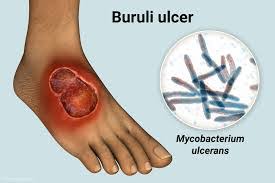What to know about Buruli Ulcer, silent flesh-eating disease
Buruli ulcer is a chronic but often neglected skin disease that leaves patients with painful scars, severe disfigurement, and, in some cases, lifelong disability.
The World Health Organisation (WHO) classifies Buruli ulcer as one of 17 Neglected Tropical Diseases (NTDs) affecting more than 120 million people in 72 countries, including Nigeria.
The infection, caused by Mycobacterium ulcerans, primarily attacks the skin, deeper soft tissues, and sometimes the bones. If left untreated, it can lead to severe disabilities and permanent disfigurement.
In Nigeria, the disease continues to affect rural communities. The country recorded 698 suspected cases of Buruli ulcers in 2024. In September, more than 50 cases and eight deaths were confirmed in Malabu, Fufore Local Government Area of Adamawa State.
Explaining the disease, a UK-based infectious disease expert and virologist, Solomon Chollom, said Buruli ulcer is caused by Mycobacterium ulcerans, a bacterium in the same family as tuberculosis and leprosy but with distinct behaviour.

“It most often begins with a lump, swelling, or hard spot on the skin that is painless and confused with an insect bite or boil,” Mr Chollom explained. “The skin then sloughs and forms a deep ulcer with wide, undermined borders.”
Where it thrives
The expert explained that scientists have yet to determine exactly how Mycobacterium ulcerans is transmitted, but “one thing is certain, it survives and multiplies best in slow-moving or stagnant water such as ponds, swamps, irrigation ditches, and riverbanks”
“Residents living near these bodies of water, farmers working near them, and fishermen fishing in them are at increased risk of exposure, particularly if they have open cuts or skin abrasions,” he said.
In Nigeria, most reported cases occur in rural, riverine villages, and the states with high numbers of Buruli ulcer cases include Ogun, Oyo, Anambra, Imo, Delta, and Cross River.
Mr Chollom noted that women and children have been predominantly affected, likely because they are exposed to water all the time for domestic use or agriculture.
He stressed that Buruli ulcer is non-infectious, meaning it cannot spread from person to person through touch or handshake, but poor hygiene, inadequate wound care, and working barefoot on farms can increase exposure.
Late diagnosis
According to Mr Chollom, the infection begins painlessly, so many people ignore early warning signs.
“Early diagnosis is what makes the difference between a small wound that heals and a big ulcer that leaves life marks,” he said. Anyone with a lump or swelling that doesn’t improve after two weeks should see a doctor.
The most reliable way to confirm the disease is through a polymerase chain reaction (PCR) test that detects Mycobacterium ulcerans DNA in the wound. Unfortunately, only a few reference laboratories in Nigeria can perform this test, and they are far from the rural areas where most cases occur.
“Public ignorance is another problem,” Mr Chollom added. “Swelling is often blamed on witchcraft or snakebite, so patients first go to traditional healers. By the time they reach a hospital, the ulcers are large and septic.”
He added that health workers’ limited experience with the disease also leads to misdiagnosis, further delaying treatment.
Disease’s severity, treatment
Buruli ulcer may not kill as many people as malaria or tuberculosis, but its long-term effects can be devastating.
“Death from Buruli ulcer is not as common, but its disability, disfigurement, and psychological trauma can destroy livelihoods and social self-esteem,” Mr Chollom warned.
He described the most tragic part as “the silent suffering of survivors who bear scars and stigma that need not have been.”
If detected early, Buruli ulcer is curable. WHO recommends an eight-week course of two oral antibiotics, rifampicin and clarithromycin, which kill the bacteria and stop further tissue destruction.
“In the past, surgery was routinely required to remove dead tissue, but nowadays antibiotics alone can be effective,” Mr Chollom said. “Large ulcers may still need wound management, skin grafting, or physiotherapy to prevent loss of movement.”
READ ALSO: Nigeria’s fertility rate drops to 4.8 children per woman — NDHS
Mr Chollom identified low awareness, limited diagnostic capacity, and poor surveillance as the main barriers to controlling the disease.
He said that due to poverty, many rural residents cannot afford transport, or the hospital stays needed for treatment. Cultural beliefs also delay care.
“Some still believe ulcers are spiritual problems, not medical ones,” he noted.
Disease prevention
There is currently no vaccine against Buruli ulcer, but prevention is simple and community based.
Mr Chollom advised that people living near swamps or rivers wear protective boots and clothing while farming or fishing, avoid bathing in muddy water when they have cuts, and treat wounds promptly.
He said Nigeria needs more health education, early case-finding, and laboratory support in endemic areas.
“Buruli ulcer is also teachable in leprosy and tuberculosis programmes by public health workers because these two diseases tend to occur together in afflicted populations,” he noted.

